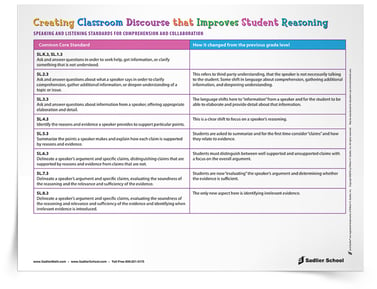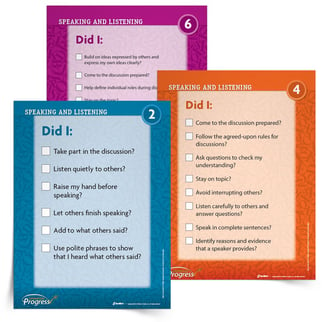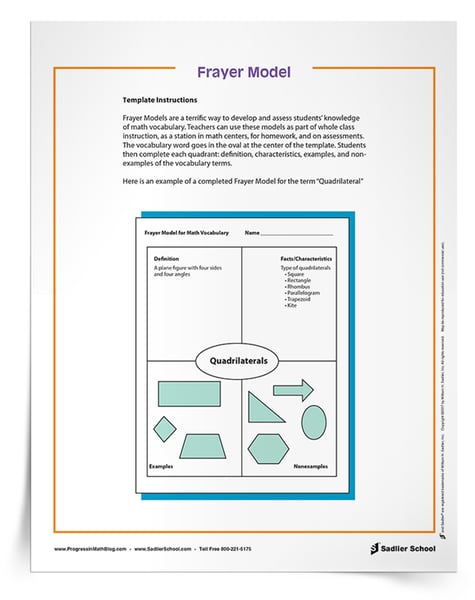January 8, 2019
Move Your Math Class from Skills-Based to Problem Solving [Free Resources]
By: Jeff Todd
Moving students from having procedural math skills to being able to use those skills to actually solve problems is one of the biggest challenges for math teachers. In this article, you'll discover how teachers can get their math classroom moving in the direction of problem-solving. Plus, I am providing a variety of free downloads that support making the shift from a focus on procedural math skills to a focus on problem-solving.
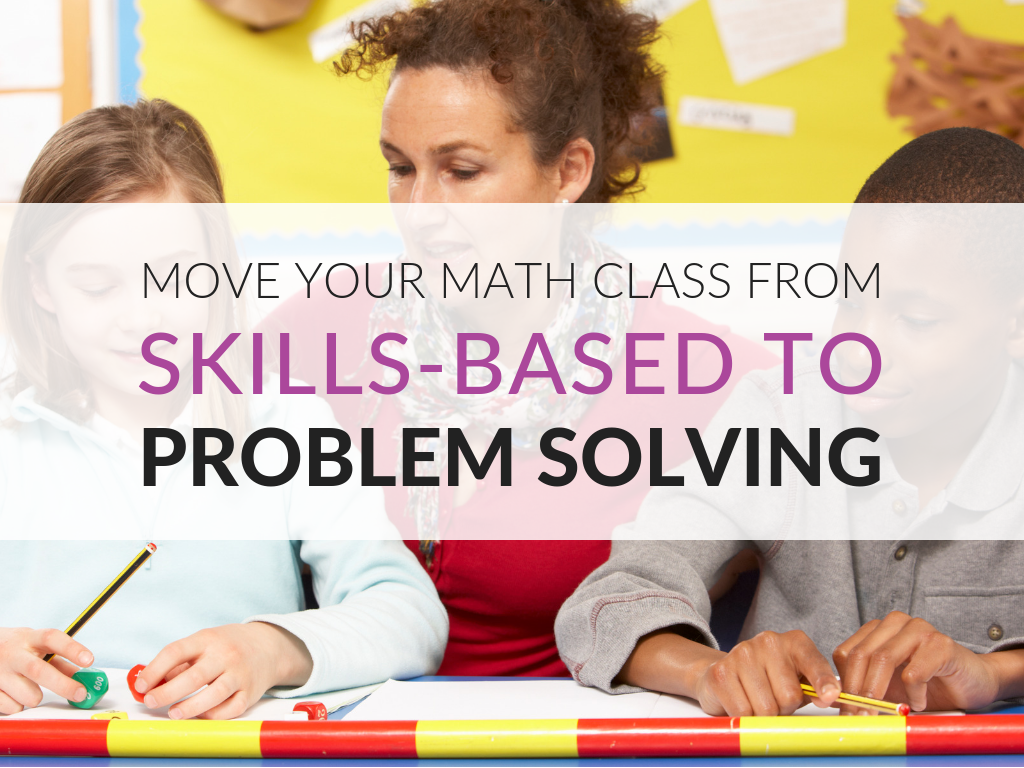
Math Curriculum Critical to Solving Problems
Many of us grew up in classrooms that were almost exclusively procedural, where test questions had just one correct answer, and drill and practice was the norm. We tend to teach in the ways that we were taught. I know that when I try something new in my classroom, if it doesn’t go well the first time I try it, I want to revert to “doing things the old way.”
But I am here today to encourage you—there are several things that you can do to move your class from simply learning procedural skills to being able to use those skills to solve problems. I am going to share three areas where you and your students can work together to change your classroom culture in order to improve problem-solving abilities for all students. At the Sadlier Math Blog, we have developed many free resources that you can download to help you move in this direction.
Making that shift, from a focus on procedural skills to a focus on problem-solving, requires teachers to be confident in the purpose for their teaching. I like the three-legged stool analogy for teaching math that I first heard when working with one of the my favorite professional developers, Andrew Chen of Edutron. A solid math education has three aspects: 1) Procedural Skills and Fluency, 2) Conceptual Understanding, and 3) Applications.
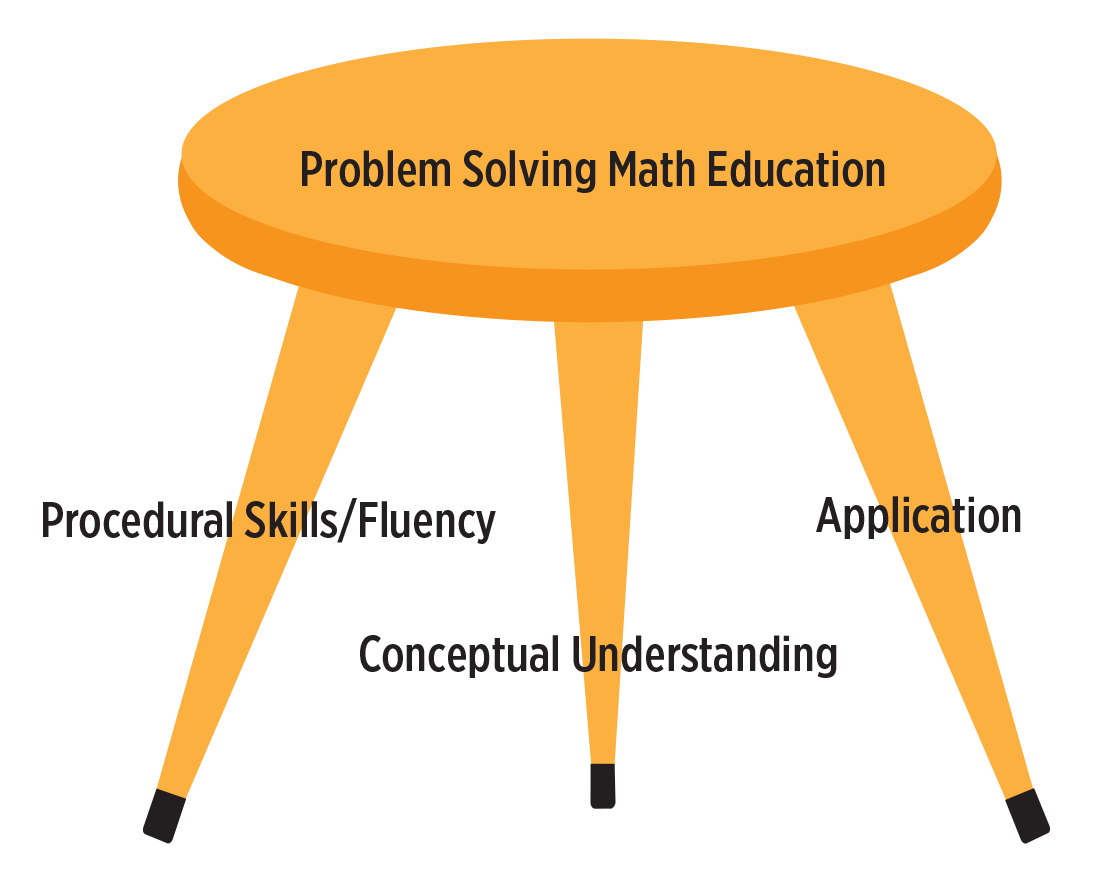
The three-legged stool analogy helps me remember that I need a balanced math curriculum in my classroom. If my stool has just one or two legs, then it is going to fall over. This might describe the kind of classroom where students have no ability to solve problems, whether they are traditional word problems or real-life problems. Even if I have all of these elements in my math curriculum, but one of the legs is shorter than the others, the stool—and my curriculum—is shaky or unstable. I’m looking for that solid three-legged stool that is going to support my students as they consider how to solve problems using their math skills as they move through the world.
These three aspects of the math curriculum are critical to solving problems:
-
Procedural Skills and Fluency—this can often be the exclusive focus of a math class. Sometime we think that without skills, students can’t solve problems, and this is true. But teachers also need to balance procedural skills with knowing why a procedure or skill is important to our daily lives or future jobs.
-
Conceptual Understanding—teachers and students need a strong, interrelated network of math skills together with mental and physical representations of those skills. Building these representations and deepening understanding is challenging. This article presents some strategies to help you in this area.
-
Applications—students need to be able to apply math procedures to problems. Problems can come from a variety of sources, including traditional word problems, open-ended problems with many solutions, purely mathematical problems, and real-world applications in physical science, social science, engineering, design, manufacturing, or the arts.
If you are a teacher who is wondering how to move in the direction of problem-solving in your classroom, I encourage you to focus on the following areas, with some free downloadable supports to help you make the transition. They are: Improving Math Discourse, Focusing on Process Standards, and Providing Scaffolding for Problem-Solving.
Improving Math Discourse In Your Classroom
One the keys to changing the focus in my math classroom from learning the “nuts and bolts” of math procedures to a focus on thinking and problem-solving was improving the quality of discourse. By discourse, I mean the level of conversation among students—whether in a classroom discussion, or by working in a group or in pairs. Students must be taught how to have an academic discussion. I discussed this in a previous blog article where you can find a more details.
One of the ways to teach students how to have academic discussions is through sentence starters or prompts. Students need to know how to start academic conversations with their peers, whether in pairs, in groups, or as a whole class. I recommend this one-page download that will give you sentence starters and prompts. Use them today to get those conversations going and make that move toward students sharing their ideas about math and problem-solving!
Another past blog post discusses being deliberate in the use of our classroom discussions. This post was inspired by Ellen Edmonds’s webinar, How Do You Get Your Students Talking Mathematically, available for free on the Sadlier website. It details classroom discourse goals, strategies, teacher moves, and implementation suggestions.
Of course, developing classroom discourse is not limited to the part of our school day that is focused on math. Classroom discourse is related to listening and speaking standards found in the Common Core State Standards for ELA and World-Class Instructional Design and Assessment (WIDA) Standards. Within these standards we can find guidance about what is appropriate and expected, by grade level, for students’ listening and speaking skills. After all, classroom, small group, or partner discourse consists of listening and speaking.
Below are two downloads for you related to these listening and speaking skills. The first shows the progression of listening and speaking skills from Kindergarten to Grade 8. This download is meant for teachers and helps you understand what students should be able to do at each grade level–noting the changes in expectations from grade to grade. The second download related to listening and speak skills is presented as a checklist for students at each grade level.
Together, these blog posts and downloads can help you make the steps to open up discourse in your classroom. This helps provide the environment where students can share their ideas and can hear their peers’ ideas. It provides the foundation for students to engage with concepts and problem-solving involved with math applications through conversations with each other and other adults in the classroom, rather than an exclusive focus on procedural skills.
|
|
|
Focusing On Process Standards
In addition to the traditional areas of math content (Numbers, Geometry, Measurement, Data Analysis, Algebra…), there are several recommendations for developing students’ process standards in mathematics. The two most common ones are the NCTM Process Standards, developed in the late 1990s, and the Standards for Mathematical Practice (SMPs), developed as part of the Common Core State Standards in the early 2010s. The process standards are central to students being able to use mathematics in the “real world” and to solve problems. They are the what that students should be talking about using the mathematical discourse strategies outlined above.
The NCTM Process Standards are:
-
Problem Solving–applying strategies to solve complex problems frequently
-
Reasoning and Proof–developing arguments and evidence to support them that might include patterns, structures, calculations and regularities
-
Communication–sharing ideas about math with peers, teachers, and the community
-
Connections–connecting mathematics to science, engineering, social issues, and the arts
-
Representation–using multiple means to demonstrate understanding of mathematical concepts with numbers, words, symbols and drawings
The Standards for Mathematical Practice are:
-
Make sense of problems and persevere in solving them.
-
Reason abstractly and quantitatively.
-
Construct viable arguments and critique the reasoning of others.
-
Model with mathematics.
-
Use appropriate tools strategically.
-
Attend to precision.
-
Look for and make use of structure.
-
Look for and express regularity in repeated reasoning.
Whether you use the NCTM Process Standard or the SMPs, I would encourage you to include them as part of your assessments. When I give quizzes or tests, I often give students two grades, one for the content being tested and one for the use of process standards (such as the use of vocabulary, explaining reasoning, correct labeling of answers, using multiple representations…). Ten to fifteen percent of the students’ report card grades would be based on the process standards. Talking about these standards and using them to grade students certainly helps build their awareness and use of them.
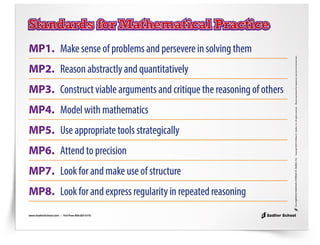 Another strategy I use is to post the SMPs in my classroom. You can download a poster here. While launching my lesson for the day, I will call attention to the SMPs that I think students will use during the lesson. During the close of the lesson, I ask students how they used those standards during the class. Sometimes they will come up with ways they used standards I had not targeted for the day!
Another strategy I use is to post the SMPs in my classroom. You can download a poster here. While launching my lesson for the day, I will call attention to the SMPs that I think students will use during the lesson. During the close of the lesson, I ask students how they used those standards during the class. Sometimes they will come up with ways they used standards I had not targeted for the day!
I have written extensively on the SMPs for the Sadlier Math Blog. If you go to the blog’s main page and click on the Math Practices Menu, you can access the blog articles by their SMP number. This particular blog article is a quick link to many of the SMP downloads available through Sadlier.
When you start to open up your classroom discourse and to use process standards as the focus of your discussions, you will see students’ thinking more clearly. This is the beginning of your long-term goal of moving your classroom from being focused only on skills to a new focus on problem solving, conceptual development, and the ability to apply mathematics to everyday problems.
Providing Scaffolding For Math Problem Solving
Finally, in addition to opening up math discourse in your classroom and using process standards to focus those class discussions, providing graphic organizers for your students will help them move to be proficient problem solvers. I have three organizers that I have developed for you—download and use them today!
Math Graphic Organizer #1– Word Problem Solving Mats
Many students struggle with word problems. One thing that is helpful is the use of multiple representation of these problems for students. In the early grades, using number bonds, ten frames, and tape diagrams, as well as words and number sentences, supports the solving of addition and subtraction word problems. As students learn about multiplication and division they can use arrays, tape diagrams, and area models. I developed these “mats” to help students make connections between these different forms of representations. They tie into the ideas presented above about classroom discourse and the use of process standards. Use these mats to have students discuss word problems they are solving (classroom discourse), the various multiple representations they can use to solve the problem (NCTM Process Standard), and the SMPs related to these representations (#1 problem solving, #4 models, and #7 structures).
Read my full blog post if you are interested in find out more about how to use these math graphic organizers in your classroom.
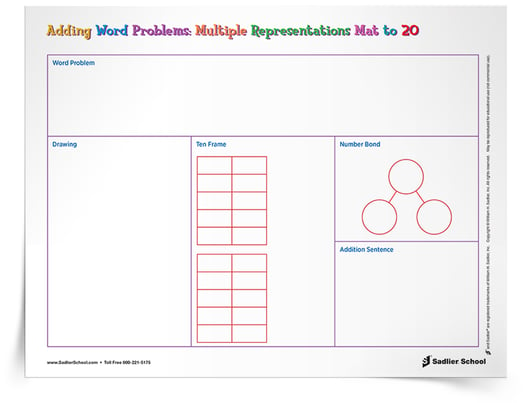
Math Graphic Organizer #2– Partner Problem-Solving Protocol
A second way to scaffold student learning for problem-solving is this Partner Problem-solving Protocol (P^3). Students solve problems, giving reasons for why they believe their answer is correct. Then a partner reads their work and agrees or disagrees with the solution through a written explanation. As discussed in the first section of the article, students need to be taught how to have discussions with a partner. By helping them structure their conversations, the partner work will be more successful and will support richer discussion between students. Read more about this protocol with its graphic organizer here or download it here.
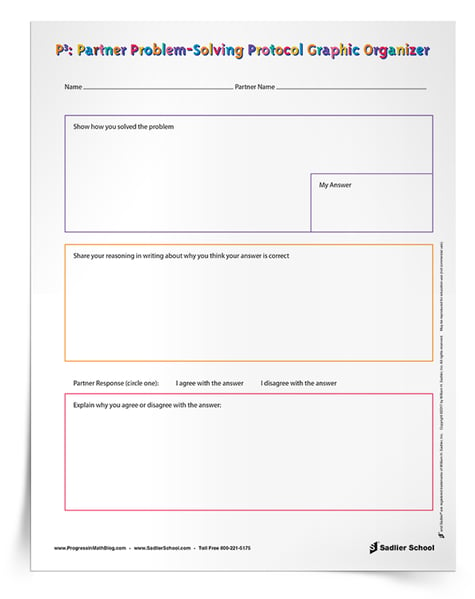
Math Graphic Organizer #3– Frayer Model
The final graphic organizer to help your students improve their mathematical discourse and ability to solve problems is the Frayer Model for vocabulary development. SMP 6 is “Attend to Precision.” While this process standard is often thought to be about exactness in calculation, the actual description of the standard refers to the precise use of mathematical vocabulary. I find that the Frayer Model organizer is useful for students in developing these precise definitions, and can be used as a basis for clarifying the meaning of key vocabulary through classroom discussions.
In Summary
I have spent a lot of time over my career investing in strategies to develop great classroom discussions. I find that these discussions are the means by which I can deepen my students’ ability to solve problems through deepening their conceptual knowledge and applying their procedural skills to the problem at hand. I have participated in great professional development that has helped me to learn how to do this and excited to share all of these resources.
For me, the key to promoting problem-solving is using classroom discussion based on the process standards (NCTM and SMPs), along with providing graphic support to help students have conversations with each other about the problems they are solving. I am sure that you will find the resources above—downloads, blog posts, and a webinar—helpful as you continue on your journey helping your students to become better problem solvers.



